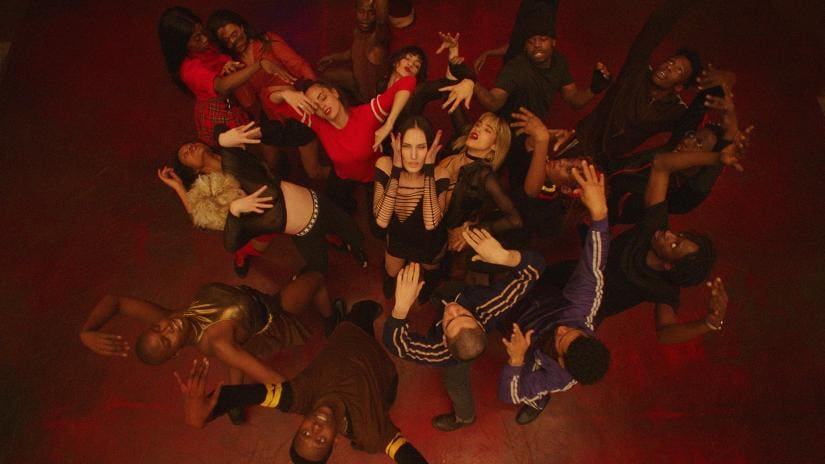
French director Gaspar Noé loves to make unpleasant films. Whether it’s 2002’s Irreversible–which centers around a horrific rape scene that never seems to stop — or 2015’s Love — which was marketed as 3D porn and totally delivers on that sensational premise — his films are not something you watch as much as something you endure. His newest film, Climax, is equally punishing, but this time, it’s also kind of fun.
Set in 1996 and allegedly based on true events, it’s a backstage musical of sorts that follows a dance troupe who meets up for a final rehearsal in an abandoned school. However, the ensuing party turns dangerous when they realize someone has spiked the sangria with LSD. If that sounds a little like Suspiria, it is. The film begins with videotaped interviews from the dancers’ auditions. The recordings play on a TV screen framed by books and movies including Dario Argentines’s Suspiria as well as Saló, or 120 Days of Sodom and both are a hint as to what the movie that follows holds.
However, before things get biblically bad, they start in ecstasy, with an orgiastic opening dance number. In a single 5-minute shot, we see the entire troupe perform together, flinging their limbs or even entire bodies across the floor as they dance to an instrumental version of Cerrone’s “Supernature.” The scene is mesmerizing and when it ends, it’s hard to suppress the urge to stand up and cheer. Though it’s supposed to be just a rehearsal, these are professional dancers and they make the performance look spontaneous, a pure expression of the dancers’ emotions and personalities that just happens to be caught on film. Unfortunately, it’s basically the film’s only major dance number.
While there is technically one more, it’s shot exclusively from above the troupe and eventually devolves into a sequence that is pretty much a litmus test for whether this film is going to work fo you. Once the dancers leave the frame, they’re replaced with words in distinct typefaces. First, we see the names of the filmmakers, then the cast, then musicians whose music is used on the soundtrack until finally, we just see Noé’s name over and over before the screen fades to black and the film’s next act begins. It’s a moment that could easily be called pretentious, but it also makes it clear what Noé is really trying to do.
As a title card that appears before the opening dance number says, this is an unabashedly French film “and proud of it” and Noé isn’t so much trying to tell a story or say anything about religion, sex or gender even though the characters’ conversations often turn philosophical. Instead, he’s pushing the concept of what a film could be to its limits. In truth, Climax is really a piece of performance art captured on film. But while it seems spontaneous and meandering, it’s clearly meticulously planned and choreographed.
Music doesn’t just play during the dance scenes, but throughout the film to constantly set the tempo for the action onscreen. Noé has always been partial to unbroken tracking shots and Climax is filled with them. However, while the characters movements through the school seem random, he and cinematographer Benoît Debie must have done extensive rehearsal to capture each scene and the music helps them choreograph that dance.
Take the extended sequence where the camera follows Sofia Boutella’s Selva as she tries to stop herself from freaking out. She wanders through the halls, pushing away other dancers and leaning against walls to take deep breaths until she finally screams and throws herself to the ground. She calms down a few minutes later, but she’s soon on the move again and it’s not long before she has another minor breakdown. It’s a brilliant bit of acting that seems utterly organic, but there are elements of dance to her movements that suggest it’s planned and the booming rhythm of the music is always giving the dancers and cameras cues about what to do next and how anxious the audience should be.
That anxiety reaches a fever pitch many times throughout the film, but it becomes punishing in the film’s final fifteen minutes, when the camera flips upside down, gets close to the ground and watches the dancers’ actions devolve into sex, grotesqueness and (more) wailing. It’s deliberately unpleasant and if the film hasn’t lost most of the audience by this point, this is probably where it loses the rest.
Climax is not for everyone, in fact, it’s pretty safe to say it’s not for almost anyone. It’s violent, sexually explicit and Noé deliberately film’s much if it in a distancing way and then forces us to sit in that unpleasantness until we’re bored or fed-up. It’s utter wankery, but I’m the type of wanker who paid to see it at 10:30 on a Saturday morning. Noé is deliberately giving a childish middle finger to the film community, America and even the audience. For viewers who think that’s sounds like fun, Climax may be one of his best.
Rating: 9/10


Comments are closed.